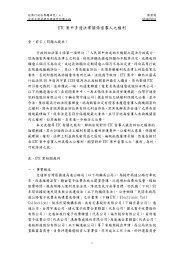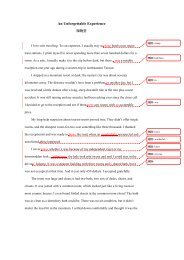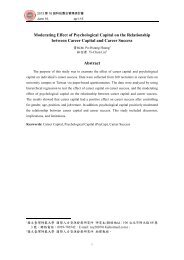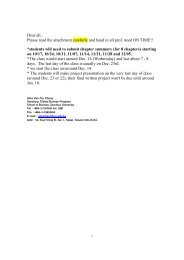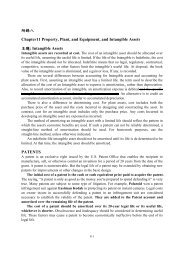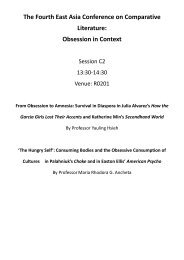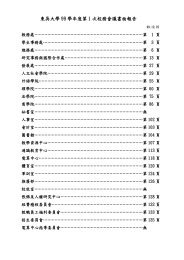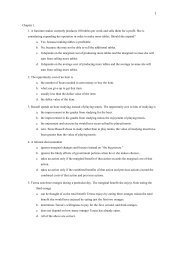The Power of the Pill: Oral Contraceptives and Women's ... - Mail
The Power of the Pill: Oral Contraceptives and Women's ... - Mail
The Power of the Pill: Oral Contraceptives and Women's ... - Mail
Create successful ePaper yourself
Turn your PDF publications into a flip-book with our unique Google optimized e-Paper software.
power <strong>of</strong> <strong>the</strong> pill 749<br />
degree in <strong>the</strong> same year <strong>and</strong> as a share <strong>of</strong> total first-year enrollments<br />
in pr<strong>of</strong>essional schools (fig. 4). 34<br />
As a fraction <strong>of</strong> B.A.’s, female entrants to law <strong>and</strong> medical schools<br />
began a steep climb around 1970. <strong>The</strong> increase, moreover, peaked in<br />
about a decade. <strong>The</strong> female share <strong>of</strong> first-year students in four major<br />
pr<strong>of</strong>essional degree programs (medicine, law, dentistry, <strong>and</strong> business)<br />
also shows a sharp break around 1970. Throughout <strong>the</strong> 1960s <strong>the</strong> ratio<br />
<strong>of</strong> women to all students was around 0.1 in medicine, 0.04 in law, 0.01<br />
in dentistry, <strong>and</strong> 0.03 in business administration. By 1980 it was 0.3 in<br />
medicine, 0.36 in law, 0.19 in dentistry, <strong>and</strong> 0.28 in business. 35<br />
Career decisions <strong>of</strong> young women changed abruptly around 1970.<br />
<strong>The</strong> shift, moreover, did not arise from an increase in <strong>the</strong> fraction <strong>of</strong><br />
female applicants admitted, at least not in <strong>the</strong> case <strong>of</strong> medical students.<br />
<strong>The</strong> change in <strong>the</strong> sex composition resulted almost entirely from an<br />
increase in applications by women to medical school. 36<br />
<strong>The</strong> large increases in women’s enrollment in lengthy pr<strong>of</strong>essional<br />
training programs, starting around 1970, resulted in a sharp rise in<br />
women’s presence in law, medicine, <strong>and</strong> o<strong>the</strong>r pr<strong>of</strong>essions across <strong>the</strong><br />
past three decades. <strong>The</strong> percentage <strong>of</strong> all lawyers <strong>and</strong> judges who are<br />
women more than doubled in <strong>the</strong> 1970s (from 5.1 percent in 1970 to<br />
13.6 percent in 1980) <strong>and</strong> was 29.7 percent in 2000. <strong>The</strong> share <strong>of</strong> female<br />
physicians increased from 9.1 percent in 1970 to 14.1 percent in 1980<br />
<strong>and</strong> was 27.9 percent in 2000. Similar patterns are apparent for occupations<br />
such as dentists, architects, veterinarians, economists, <strong>and</strong> most<br />
<strong>of</strong> <strong>the</strong> engineering fields. 37<br />
34<br />
<strong>The</strong> vast majority <strong>of</strong> first-year pr<strong>of</strong>essional students are recent B.A.’s. We have also<br />
examined <strong>the</strong> change in undergraduate majors from <strong>the</strong> mid 1960s to <strong>the</strong> late 1970s. <strong>The</strong><br />
fraction <strong>of</strong> female B.A.’s majoring in traditionally female concentrations (e.g., education<br />
<strong>and</strong> English) decreased from <strong>the</strong> mid 1960s, but with far greater speed after 1971. <strong>The</strong><br />
fraction majoring in <strong>the</strong> physical <strong>and</strong> biological sciences, math, <strong>and</strong> engineering decreased<br />
a bit until 1971 but subsequently rose steeply.<br />
35<br />
<strong>The</strong> ratio <strong>of</strong> female to male pr<strong>of</strong>essional school students continues to rise even when<br />
<strong>the</strong> percentage <strong>of</strong> female B.A.’s who enter pr<strong>of</strong>essional school does not. <strong>The</strong> reason is<br />
beyond <strong>the</strong> scope <strong>of</strong> this paper <strong>and</strong> concerns <strong>the</strong> decrease in <strong>the</strong> share <strong>of</strong> male B.A.’s,<br />
<strong>and</strong> <strong>of</strong> all B.A.’s, entering pr<strong>of</strong>essional schools.<br />
36<br />
See Cole (1986) <strong>and</strong> Goldin <strong>and</strong> Katz (2000) for evidence that virtually all <strong>of</strong> <strong>the</strong><br />
increase in female medical students, beginning around 1970, resulted from an increase<br />
in applications from women.<br />
37<br />
Overall, <strong>the</strong> female share <strong>of</strong> employment in pr<strong>of</strong>essional occupations (excluding teachers<br />
<strong>of</strong> kindergarten through grade 12 <strong>and</strong> health assessment occupations such as nurse)<br />
increased from 19.9 percent in 1970, to 27.4 percent in 1980, <strong>and</strong> to 37.5 percent in 2000.<br />
<strong>The</strong> female share <strong>of</strong> <strong>the</strong>se occupations barely changed from 1950 to 1970. (<strong>The</strong> 1950–80<br />
data are tabulated from <strong>the</strong> Integrated Public Use Microdata Series [Ruggles <strong>and</strong> Sobek<br />
1997]; those for 2000 are taken from U.S. Department <strong>of</strong> Labor [2001, table 11].) Fur<strong>the</strong>rmore,<br />
cohort-based analyses show large increases in <strong>the</strong> share <strong>of</strong> women younger than<br />
40 years gaining employment in high-wage pr<strong>of</strong>essional <strong>and</strong> managerial occupations starting<br />
with cohorts born in <strong>the</strong> late 1940s to early 1950s (Black <strong>and</strong> Juhn 2000).




